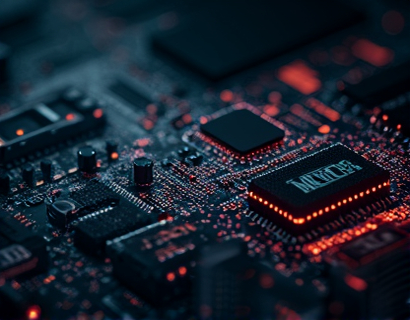Next-Gen Smart Contract AMMs: Revolutionizing DeFi Trading
In the rapidly evolving world of decentralized finance, Automated Market Makers (AMMs) have emerged as a cornerstone technology, facilitating seamless and efficient trading experiences. The next generation of smart contract AMMs is pushing the boundaries of what is possible in decentralized trading, introducing advanced automation and sophisticated liquidity management. This article delves into the cutting-edge features and benefits of these advanced AMMs, designed to elevate the DeFi trading landscape.
Understanding Smart Contract AMMs
Before exploring the advancements, it's essential to understand the basics of smart contract AMMs. Unlike traditional order books, AMMs use mathematical formulas and liquidity pools to determine prices and execute trades. This approach eliminates the need for order books and reduces the risk of price manipulation. Smart contract AMMs leverage blockchain technology to ensure transparency, security, and decentralization, making them a preferred choice for crypto traders and DeFi enthusiasts.
Advanced Automation in AMMs
The next generation of AMMs introduces advanced automation features that significantly enhance trading efficiency. One of the key innovations is the implementation of algorithmic trading strategies directly within the smart contract. These algorithms can analyze market conditions, identify trading opportunities, and execute trades automatically, without human intervention. This level of automation not only reduces the potential for human error but also allows traders to capitalize on market movements in real-time.
Another advanced feature is the integration of machine learning models to predict market trends and optimize trading strategies. By leveraging historical data and real-time market insights, these models can make informed decisions, adjusting trade parameters to maximize returns and minimize risks. This intelligent automation ensures that traders can focus on higher-level strategies while leaving the execution to the AMM's sophisticated algorithms.
Enhanced Liquidity Management
Liquidity management is a critical aspect of AMMs, and the next generation of smart contract AMMs offers significant improvements in this area. One of the most notable advancements is the introduction of dynamic liquidity provisioning. Unlike traditional AMMs that rely on fixed liquidity pools, dynamic provisioning adjusts the pool sizes based on market demand and liquidity needs. This adaptive approach ensures that liquidity is always available where it's needed most, reducing slippage and improving trade execution.
Furthermore, these advanced AMMs incorporate sophisticated risk management tools. Liquidity providers can set custom risk parameters, such as maximum drawdown or exposure limits, to protect their assets. The smart contract monitors these parameters in real-time and automatically adjusts liquidity allocations to maintain the desired risk profile. This level of control empowers liquidity providers to manage their risks effectively while contributing to the overall health of the DeFi ecosystem.
Interoperability and Cross-Chain Capabilities
Interoperability is a game-changer in the DeFi space, and the next-gen AMMs are at the forefront of this trend. These AMMs support cross-chain transactions, allowing assets to be seamlessly moved between different blockchain networks. This feature not only broadens the liquidity base but also enhances the utility of the AMM by tapping into a larger pool of assets and traders. The use of interoperability protocols ensures smooth and secure asset transfers, making the trading experience more fluid and accessible.
Additionally, these AMMs are designed to work across multiple protocols and platforms, fostering a more interconnected DeFi ecosystem. This cross-chain capability enables traders to leverage the strengths of different blockchains, such as Ethereum's smart contract capabilities and Binance Smart Chain's lower transaction fees, optimizing their trading strategies based on specific blockchain advantages.
User-Friendly Interface and Onboarding
Despite the complexity of advanced features, the next-generation AMMs prioritize user experience. A intuitive and user-friendly interface ensures that traders of all skill levels can navigate the platform with ease. The onboarding process is streamlined, guiding users through the setup of their liquidity pools and trading strategies. Interactive tutorials and real-time feedback help new users understand the mechanics of the AMM and make informed decisions.
Moreover, the platform offers customizable dashboards where users can monitor their liquidity positions, trade history, and performance metrics. This transparency and control empower users to manage their DeFi activities effectively, enhancing overall satisfaction and trust in the platform.
Security Enhancements
Security remains a top priority in the DeFi space, and the next-gen AMMs have implemented robust measures to protect user assets. Smart contract audits by leading security firms ensure that the code is free from vulnerabilities. Additionally, multi-signature wallets and cold storage solutions are used to safeguard funds, minimizing the risk of hacks and unauthorized access.
These AMMs also incorporate advanced encryption techniques and decentralized identity verification to enhance security. Users can opt for zero-knowledge proofs and other privacy-preserving technologies to maintain the confidentiality of their transactions. This comprehensive security framework builds trust and encourages broader adoption of the platform.
Case Studies and Real-World Applications
To illustrate the practical benefits of these advanced AMMs, consider a few real-world scenarios. A liquidity provider sets dynamic risk parameters to manage exposure during a volatile market period. The AMM automatically adjusts the liquidity pool sizes, ensuring that the provider's assets are protected while still participating in profitable trades. This adaptive risk management leads to consistent returns even in turbulent markets.
Another example involves a trader using cross-chain capabilities to execute a multi-asset trade across Ethereum and Polygon. The AMM seamlessly facilitates the transfer of assets between blockchains, executing the trade with minimal latency and fees. This efficiency not only saves time but also reduces costs, making the trading strategy more viable and attractive.
Future Prospects and Innovations
The future of smart contract AMMs is promising, with several innovations on the horizon. One area of focus is the integration of decentralized oracles to provide real-time market data directly within the AMM. This ensures that trading algorithms have access to accurate and up-to-date information, further enhancing the precision of automated trades.
Another exciting development is the incorporation of governance tokens, allowing the community to have a say in the evolution of the AMM. Token holders can propose and vote on upgrades, new features, and parameter adjustments, fostering a more democratic and community-driven platform. This governance model not only enhances transparency but also aligns the interests of users and developers, driving continuous improvement.
Additionally, the exploration of layer 2 solutions and state channels could further optimize transaction speeds and reduce costs. By offloading some of the processing to these secondary layers, the AMM can handle a higher volume of trades without compromising performance. This scalability is crucial for the widespread adoption of DeFi platforms.
Conclusion
The next-generation smart contract AMMs represent a significant leap forward in DeFi trading, offering advanced automation, enhanced liquidity management, and robust security features. These innovations not only improve the trading experience but also open up new possibilities for liquidity providers and traders alike. As the DeFi ecosystem continues to evolve, these AMMs will play a pivotal role in shaping the future of decentralized finance, making it more accessible, efficient, and user-friendly.











































